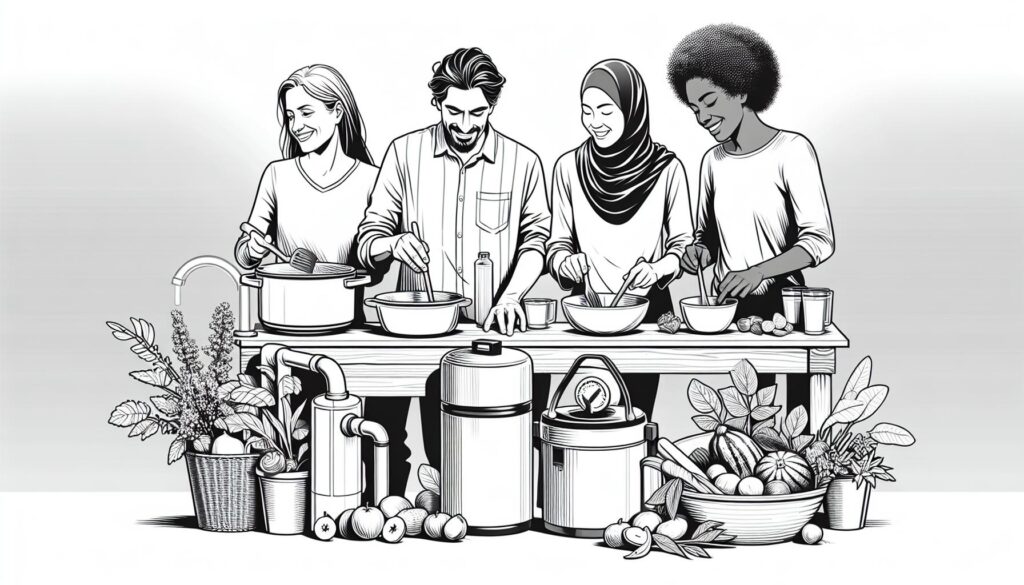Cooking sustainably is not just about the ingredients we use; it also involves being mindful of our water consumption. In my experience, incorporating water-saving practices into your cooking routine can make a significant impact on the environment. From washing vegetables efficiently to reusing cooking water, there are plenty of simple yet effective ways to conserve water in the kitchen.
As a seasoned cook and sustainability enthusiast, I’ve learned that small changes in our cooking habits can lead to big savings in water usage. By adopting water-saving tips and tricks, not only can we reduce our environmental footprint, but we can also inspire others to follow suit. Join me on this journey towards more sustainable cooking practices that benefit both our planet and our future generations.
Importance of Conserving Water in Cooking
Water is essential in the cooking process as it helps in food preparation, cleaning, and various culinary tasks. However, it’s crucial to be mindful of our water usage to promote sustainability. By conserving water in cooking, we can make a significant impact on the environment.
As a seasoned cook, I understand the importance of minimizing water wastage in the kitchen. Every drop counts, and small changes in our cooking routines can lead to substantial water savings over time. By adopting water-saving practices, we not only reduce our environmental footprint but also contribute to a more sustainable future for our planet.
When we waste water in cooking, we are not just wasting a precious resource; we are also increasing our carbon footprint. The energy used to treat and pump water to our homes contributes to greenhouse gas emissions. Therefore, by using water efficiently in the kitchen, we are indirectly reducing our overall impact on climate change.
Incorporating water-saving tips into our daily cooking habits is a simple yet powerful way to promote environmental consciousness. It’s a small change that can make a big difference in the long run. By being mindful of our water usage and adopting sustainable practices, we can inspire others to join us in creating a more eco-friendly culinary culture.
Efficient Vegetable Washing Techniques
When it comes to washing vegetables, I focus on efficiency to minimize water usage while ensuring cleanliness. Did you know that rinsing vegetables in a large bowl or container filled with water instead of under running water can save a significant amount of water?
Here are some important tips to wash vegetables efficiently:
- Use a vegetable brush: Scrubbing vegetables with a brush under running water can waste water. Instead, fill a basin with water, add a splash of vinegar, and use a vegetable brush to clean them thoroughly.
- Soak leafy greens: Rather than rinsing leafy greens under running water, fill a clean sink or a basin with water, submerge the greens, and gently swish them around. This method helps remove dirt without wasting excess water.
- Utilize a colander: Washing multiple vegetables simultaneously in a colander allows you to rinse them all together, saving time and water. It’s a simple yet effective way to conserve water in your cooking routine.
By adopting these efficient vegetable washing techniques into your culinary practices, you not only reduce water wastage but also contribute to a more sustainable way of cooking.
Reusing Cooking Water: A Sustainable Practice
When it comes to sustainable cooking practices, reusing cooking water is a smart and eco-friendly approach that not only saves water but also reduces waste. Instead of letting that valuable water go to waste down the drain, consider giving it a second life in your recipes. Here are a few ways I incorporate this practice into my cooking routine:
- Pasta Water: After boiling pasta, I often save some of the starchy pasta water to add body and flavor to sauces or soups. The natural starch in the water helps thicken sauces and bind ingredients together, adding depth to the dish without the need for extra ingredients.
- Vegetable Blanching Water: When blanching vegetables, I make sure to use a pot of water efficiently by blanching multiple batches of vegetables in the same water. This not only saves time but also ensures that the nutrients released from the veggies are retained in the water for a flavorful vegetable broth or soup base.
- Rice Water: The water used to rinse rice before cooking can also be repurposed. Instead of discarding it, I use it to water houseplants as it contains nutrients released from the rice grains during rinsing. It’s a simple yet effective way to reduce water wastage in the kitchen.
By incorporating these water-saving practices into my cooking routine, I not only reduce water usage but also add extra flavor and nutrients to my dishes. It’s a small change that can make a big difference in promoting sustainability in the kitchen.
Optimizing Water Usage in Kitchen Appliances
When it comes to water-saving in the kitchen, being mindful of kitchen appliances is crucial. Here are some tips to optimize water usage efficiently:
- Dishwasher: Always ensure the dishwasher is fully loaded before running it to maximize water efficiency.
- Faucet: Fix any leaks promptly to prevent unnecessary water wastage.
- Refrigerator: Check and maintain the refrigerator’s water filter regularly to avoid water-related issues.
- Cooking Appliances: Use just enough water to cover ingredients when boiling or steaming to minimize excess water usage.
Remember, small changes in how we use water in our kitchen appliances can collectively make a significant impact on water conservation efforts.
Inspiring Others to Embrace Water-Saving Cooking
When it comes to embracing water-saving cooking practices, leading by example can make a significant impact. Did you know that by sharing my sustainable cooking journey with friends and family, I’ve been able to inspire them to adopt similar habits? It’s truly gratifying to see them not only appreciate the environmental benefits but also enjoy the cost savings that come with efficient water usage in the kitchen.
One effective way to encourage others is to showcase the tangible results of these practices. For instance, I’ve highlighted the reduction in my water bills since implementing water-saving techniques in my cooking routine. This practical demonstration has resonated with many, showing them that small changes can lead to substantial savings over time.
Additionally, sharing engaging content on social media platforms can reach a wider audience and spark conversations about the importance of water conservation in cooking. I’ve found that posting quick tips, fun facts, and before-and-after pictures of my sustainable kitchen improvements has generated positive feedback and encouraged others to make similar changes in their own homes.
Moreover, organizing or participating in community events focused on sustainable cooking can provide a platform to inspire and educate others. Through my experience, hosting workshops on water-saving cooking techniques has been an excellent way to connect with like-minded individuals, exchange ideas, and collectively work towards a greener future.
Ultimately, by being a vocal advocate for water-saving practices in cooking, we can inspire a ripple effect of positive change in our communities and beyond. Together, we can empower others to embrace sustainable habits that not only benefit the environment but also lead to a more mindful and resourceful approach to cooking.
Key Takeaways
- Conserving Water in Cooking: Being mindful of water usage in the kitchen not only promotes sustainability but also reduces our environmental footprint and contributes to a more sustainable future.
- Efficient Vegetable Washing: Adopting efficient techniques like using a vegetable brush, soaking leafy greens, and utilizing a colander can help conserve water while maintaining cleanliness.
- Reusing Cooking Water: Incorporating practices like using pasta water, vegetable blanching water, and rice water in cooking can save water, reduce waste, and enhance the flavor and nutrients in dishes.
- Optimizing Water Usage in Appliances: Making small changes in how we use kitchen appliances, like running the dishwasher when full and fixing leaks promptly, can collectively make a significant impact on water conservation efforts.
- Inspiring Others: Leading by example, sharing results, engaging on social media, and participating in community events can inspire others to embrace water-saving cooking practices and contribute to a more sustainable future.
Conclusion
Embracing water-saving cooking practices is not just a personal choice; it’s a powerful way to inspire positive change in our communities. By leading by example and sharing our sustainable cooking journeys, we can motivate others to join the movement. From reducing water bills to showcasing kitchen improvements on social media, every action counts in promoting a more sustainable future. Engaging in community events and workshops focused on sustainable cooking amplifies our message of water conservation. Together, we can create a ripple effect of environmentally friendly and resourceful cooking habits that benefit both our planet and our well-being. Let’s continue advocating for water-saving practices and empower others to make a difference through conscious culinary choices.



